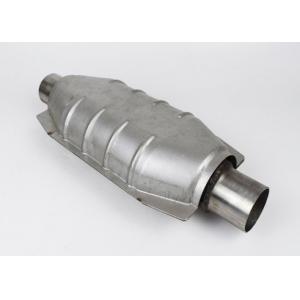

Add to Cart
Stainless Steel Auto Universal Performance Catalytic Converter
Product description
A catalytic converter is an exhaust emission control device that reduces toxic gases and pollutants in exhaust gas from an internal combustion engine into less-toxic pollutants by catalyzing a redox reaction (an oxidation and a reduction reaction). Catalytic converters are usually used with internal combustion engines fueled by either gasoline or diesel—including lean-burn engines as well as kerosene heaters and stoves.
Application
Although catalytic converters are most commonly applied to exhaust systems in automobiles, they are also used on electrical generators, forklifts, mining equipment, trucks, buses, locomotives, and motorcycles. They are also used on some wood stoves to control emissions.[5] This is usually in response to government regulation, either through direct environmental regulation or through health and safety regulations.
Catalytic converters require a temperature of 800 degrees Fahrenheit (426 °C) to efficiently convert harmful exhaust gases into inert gases, such as carbon dioxide and water vapor. Therefore, they are placed as close to the engine as possible.
Types
Two-way
A 2-way (or "oxidation", sometimes called an "oxi-cat") catalytic
converter has two simultaneous tasks:
Oxidation of carbon monoxide to carbon dioxide: 2 CO + O2 → 2 CO2
Oxidation of hydrocarbons (unburnt and partially burned fuel) to
carbon dioxide and water: CxH2x+2 + [(3x+1)/2] O2 → x CO2 + (x+1)
H2O (a combustion reaction)
This type of catalytic converter is widely used on diesel engines
to reduce hydrocarbon and carbon monoxide emissions. Because of
their inability to control oxides of nitrogen, they were superseded
by three-way converters.
Three-way
Three-way catalytic converters (TWC) have the additional advantage of controlling the emission of nitric oxide (NO) and nitrogen dioxide (NO2) (both together abbreviated with NOx and not to be confused with nitrous oxide (N2O)), which are precursors to acid rain and smog.
Since 1981, "three-way" (oxidation-reduction) catalytic converters have been used in vehicle emission control systems in the United States and Canada; many other countries have also adopted stringent vehicle emission regulations that in effect require three-way converters on gasoline-powered vehicles. The reduction and oxidation catalysts are typically contained in a common housing; however, in some instances, they may be housed separately. A three-way catalytic converter has three simultaneous tasks.
Packaging and delivery
| Package | 1pc/white paper box, 10pcs/master carton |
| Delivery method | By express, By air, By sea |
| Delivery time | Depends on order quantity |
| Shipment terms | EXW, FOB CHINA, CNF CHINA, CIF CHINA |
Related products
Stainless steel / aluminized exhaust resonator and muffler in dozen model and dimensions for customer's choice.
Welcome your inquiry if you are interested in our products.
